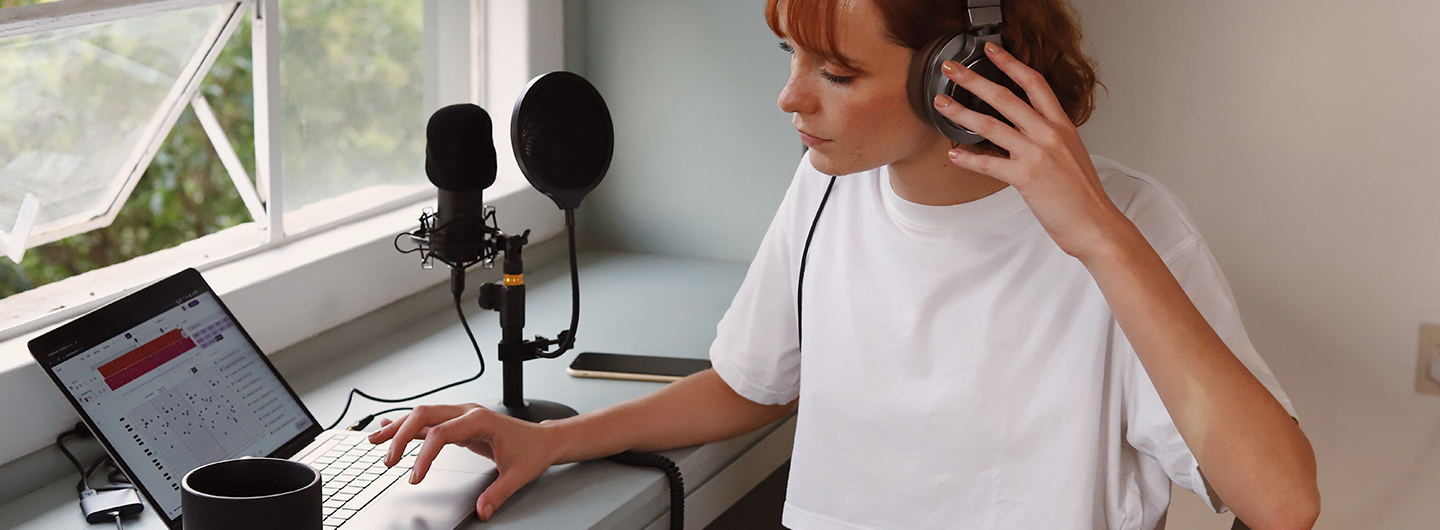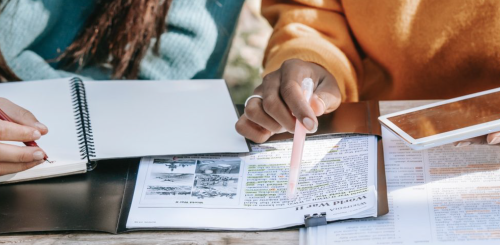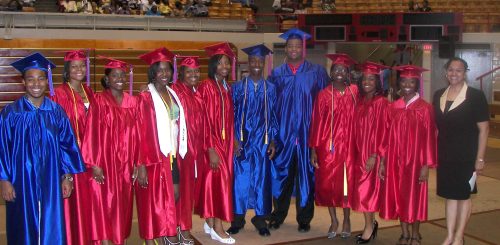
5 Things Every New Music Producer Should Know
October 25, 2022Many people dream of becoming music producers; these days, audio production software is more accessible than ever. All a future music producer needs is access to wi-fi connected devices to begin their music production journey and experiment with the power of sound.
Today, mastering the art of audio production opens new doors beyond pure music. Those equipped with the knowledge of audio production can work in film, TV production, live performance, or even podcasting.
As an educator, you can help your students develop skills in audio production by helping them create a solid foundation in music production and teaching them how to work effectively with other producers, artists, and collaborators.
Regarding audio production, there is no right or wrong way to progress along the creative journey. However, there are a few important skills that you can teach your students to actualize their unique sounds, collaborate with other artists, and begin sharing with the rest of the world.
5 Things Every New Music Producer Should Know
Music production is a broad term for mastering several skills to create professional, high-quality songs. The entire process is highly complex, with many different steps, but the right tools can simplify the audio production journey. Although you’re an educator, you may not be familiar with every detail of the music production process. No worries! Easy-to-use DAWs like Soundtrap for Education can help your students produce professional quality sound through guided education
Here are 5 elements of music production you’ll need to understand before teaching your students about music production.
-
Music Theory
For most new music producers, music theory may appear intimidating at first. However, music theory is quite simple, but people can find it challenging because music theory uses visual mediums to describe the sound.
Today, it’s easier than ever for up-and-coming music producers to begin creating music. Modern music production software is intuitive and straightforward, which might discourage users from learning the fundamentals of music theory. Furthermore, some students may be worried that the rules and structure of music theory are too difficult to learn.
In reality, understanding music theory will allow students to add depth to their tracks and communicate effectively with other artists. For instance, students can learn about the range of different vocals, understand how to adjust tracks to appropriate scales, and establish a song’s structure. By teaching students music structure from the fundamentals, your students will be able to develop their music knowledge and will be more likely to contribute to the music-making process.
-
Songwriting
If your students want to learn how modern music is made today, consider teaching them about songwriting. Understanding the different elements that make up a song, its structure, and what qualifies as a melody can help them build off the fundamentals learned in music theory.
Learning songwriting allows students to create a narrative structure for a story, develop a methodology for telling that story, and create consistency in their storytelling. Your students don’t need to create a musical masterpiece. Instead, motivate them to delve deeper into their stories to bolster a genuine understanding of songwriting. By understanding each element of the songwriting process, the future music producers in your classroom can see why or why not a track, a hook, or a chorus may resonate with a particular audience.
After writing their songs, you may wonder how you can help your students clean up their lyrics and add the necessary elements to make them sound as clear as possible. After uploading their lyrics to the DAW, your students can begin mixing their music.
-
Mixing and Mastering
When it comes to audio production, mixing and mastering are two sides of the same coin. During the audio mixing process, your students can adjust and combine multiple pre-recorded tracks to create their “mix.” Students can learn how to blend their lyrics, insert loops and beats, and create a better overall song during mixing.
Once they have a solid audio recording, they can balance their levels, pan the song and process the audio. The goal of audio mixing is to ensure that all of the tracks work together to create a balanced, easy-to-hear song.
After mixing the track, your students will begin audio mastering, which is the last step in music production. Any mistakes in the track should have been addressed during audio mixing, so when it’s time to master the track, subtle adjustments can be made to polish the track’s overall sound. Audio mastering is all about bringing out the best in a mix by adding a little reverb, adjusting the saturation, and more for a song that’s ready for streaming.
Remember that mixing and mastering are two separate skills that can take years to perfect. But, they’re vital to the success of a music producer. As music producers progress and begin working with a team, they may offload these duties to audio engineers. However, learning these skills early on makes it easier to communicate with others. To begin, our students can learn how to collaborate through audio mixing and mastering.
-
Understand the DAW
The digital audio workstation (DAW) is where the magic music is made. However, learning to use a DAW is akin to learning an instrument. It will take time, and some are easier to use than others. Ask yourself the following questions to find the right DAW for your music class:
- Is this DAW compatible with school laptops?
- Are there beginner-friendly tutorials for this DAW?
- Will this DAW allow my students to collaborate with each other?
First off, you won’t be able to use your DAW if it’s not compatible with your current operating system. Double-check compatibility before committing your students to a certain program. Additionally, some DAWs come equipped with online tutorials. Others come with lesson plans that can help your students learn and supplement your existing lessons.
Although most DAWs come with plenty of preset loops, sound effects, and beats, collaboration is essential for any of your students aiming to become future music producers. Find a DAW that can help you in the end goal of making your students better learners and collaborators. These are requirements for any great music producer.
Some DAWs are more beginner-friendly than others, but choosing the right DAW for your student’s needs will place you in the right position for better long-term adherence. Once you’ve chosen a DAW, take the time to learn the ins and outs of its unique functionalities. Another useful step is learning about its user interface before presenting it to your classroom. If you understand the DAW, it can be easier to teach your students without breaking their creative flow.
-
Communication and Collaboration
Communicating and collaborating with other artists is crucial for any future music producer. Many music producers and musicians make the mistake of failing to develop their communication skills. This is because they believe solitude is the best option for unlocking creativity. Although some alone time is useful for your students when initially creating lyrics and songwriting, communication is essential to finding what works and what doesn’t for a song. Communicating with others allows students to learn how to manage multiple moving parts and bring out the best in each other.
Collaboration will empower your students’ creative flow. This will allow them to produce well-rounded, polished tracks. As they go through their educational journey, teaching the importance of collaboration will open their ears to new ideas and present different methodologies for problem-solving. For the student that wants to become a music producer, they’ll be able to hone their skills. Additionally, they’ll fully understand the intricacies of making a published song or album.
Although working alone can sometimes be beneficial for some students, learning to work with others is essential to building long-term skills. Plus, students no longer need to be in the same room as peers to collaborate, create, and connect. Modern DAW software that’s collaboration-oriented is device-agnostic. It allows students to collaborate from anywhere in the world at any time.
Start Your Music Production Journey with Soundtrap for Education
Soundtrap for Education is the ultimate audio production platform for students and teachers to create and edit audio recordings. Pupils and educators can easily tap into their artistic side with this intuitive audio platform. The platform facilitates a creative learning environment for every subject, regardless of the student’s age or experience level.
With Soundtrap for Education, students and teachers can collaborate with advanced cloud technology at any time or place. In addition, the platform is equipped with a robust resource portal. This portal comes equipped with tutorials, an external curriculum, and lesson plans to complete the educational experience. To ensure privacy, teachers can ensure that student collaboration is safe and secure with invite-only groups in Soundtrap’s versatile digital environment.
If you’re ready to enhance your educational experience with an intuitive cloud-based audio production platform, get started today with Soundtrap for Education! Share this article with other teachers in your network to help spread the joy of learning through sound.
 EDU Portal
EDU Portal


